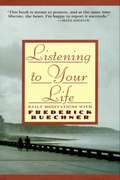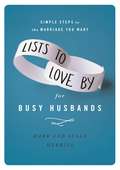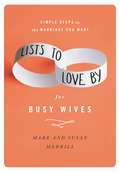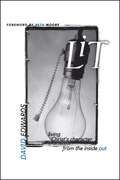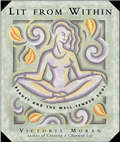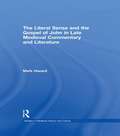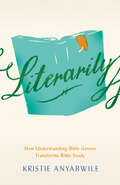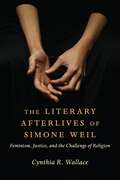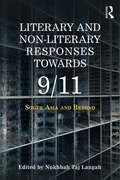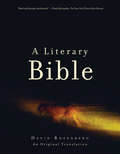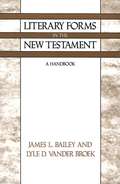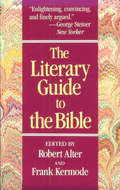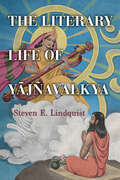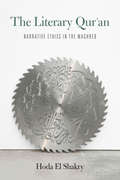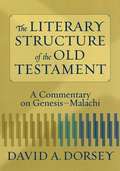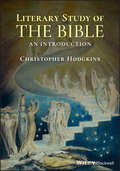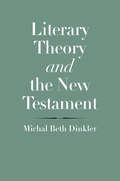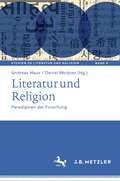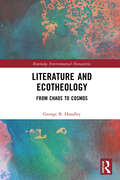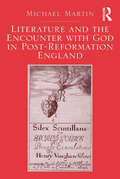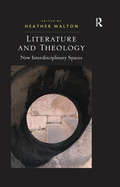- Table View
- List View
Listening to Your Life
by Frederick BuechnerDaily meditations taken from the works of an acclaimed novelist, essayist, and preacher who has articulated what he sees with a freshness and clarity and energy that hails our stultified imaginations.
Lists to Love By for Busy Husbands: Simple Steps to the Marriage You Want
by Susan Merrill Mark MerrillThe founders of Family First, Mark and Susan Merrill, present a collection of lists created for the busy husband who wants a more intimate, fulfilling union with his wife. Husbands and wives bring different personalities, upbringings, experiences, and expectations into their marriage, which can lead to miscommunication and emotional turmoil. LISTS TO LOVE BY FOR BUSY HUSBANDS presents practical dos and don'ts along with step-by-step advice for husbands who want to bridge the emotional gap and improve their marriage. Mark and Susan Merrill understand that couples crave love, but don't always know how to express it to one another. These thirty lists will carry husbands through an entire month of learning to love their wives more deeply--wisdom they will come back to again and again. These real-life answers from a Christian perspective will help readers evaluate, refresh, and strengthen their own marriage.
Lists to Love By for Busy Wives: Simple Steps to the Marriage You Want
by Susan Merrill Mark MerrillFrom Mark and Susan Merrill, the founders of Family First, comes a collection of lists created for the busy wife who wishes to strengthen her marriage and love her husband well.It's no secret that there is a wide emotional gap between men and women. Couples crave love and attention from one another, but they don't always know how to show it. LISTS TO LOVE BY FOR BUSY WIVES presents creative and practical ways for wives to bridge this gap and improve their relationship. These thirty lists will carry wives through an entire month of learning to love their husbands more deeply with advice they will come back to again and again. From lists addressing a wide range of topics, readers will learn to set better expectations for their marriage, to communicate more effectively with their husband, to build a deeper foundation of love in their marriage, and much more.
Lit
by David EdwardsIn this provocative book, nationally recognized speaker David Edwards delivers thirteen ways to ignite the fire within and learn what it means to live out your faith in a post-modern world.With boldness and cutting-edge insight, David Edwards turns the light on false perceptions of religion and gets down to the truth about the "cosmic" battle between light and dark. Describing the disconnect existing in "Sunday faith" and the rest of the week, Edwards defines character as "the life of God living in us." In this provocative book, nationally recognized speaker David Edwards delivers thirteen ways to ignite the fire within and learn what it means to live out your faith in a post-modern world. After reading just a few pages, you'll discover that Edwards' pen blazes with the same passion, enthusiasm, and humor that have made him a highly sought-after national speaker. Practical "Spotlight" exercises at the end of each chapter are designed to help you transfer the truth of each chapter into your everyday experience, and thought-provoking questions for both groups and individuals will help you ignite the light within your heart and teach you how to live the lit life.
Lit
by David EdwardsWith boldness and cutting-edge insight, David Edwards turns the light on false perceptions of religion and gets down to the truth about the "cosmic" battle between light and dark. Hitting head-on the disconnect that exists in "Sunday faith" and the rest of the week, Edwards defines character as "the life of God living in us." In this provocative book, nationally recognized speaker David Edwards delivers thirteen ways to ignite the fire within and learn what it means to live out your faith in a post-modern world. After reading just a few pages, you'll discover that Edwards' pen blazes with the same passion, enthusiasm, and humor that have made him a highly sought-after national speaker. Practical "Spotlight" exercises at the end of each chapter are designed to help you transfer the truth of each chapter into your everyday experience, and thought-provoking questions for both groups and individuals will help you ignite the light within your heart and teach you how to live the lit life.
Lit From Within
by Victoria MoranBeauty isn't skin deep -- it's soul deep Women's wellness visionary Victoria Moran offers inspiring advice and practical suggestions that will make any woman look and feel more radiant. Each compact essay contains a tip you can put to use today to heighten your awareness of your own inner beauty, illustrating how true sparkle comes from a sense of wholeness. Women of all ages will relate to Victoria's reflections on her journey to a deeper understanding of inner radiance -- beauty that is soul deep. This sane, sensible approach to a strong self-image and loving self-care is firmly grounded in spiritual common sense, the marriage of body and soul. You start by lighting up your life -- and before you know it, you're lighting up the room.
The Literal Sense and the Gospel of John in Late Medieval Commentary and Literature (Studies in Medieval History and Culture #12)
by MArk HazardFirst Published in 2003. Routledge is an imprint of Taylor & Francis, an informa company.
Literarily: How Understanding Bible Genres Transforms Bible Study
by Kristie AnyabwileDon&’t just read the Bible literally—read it Literarily.A lot of times, we treat Scripture like it&’s all the same from Genesis to Revelation. After all, it only has one Author. Isn&’t it just one big book, identical from beginning to end?While it&’s true that the Bible is unified, it is also diverse. The Bible can be grouped according to key categories, called genres, that help us to read and properly interpret the Scriptures. An understanding of these genres, and the literary themes and devices used within them, makes all the difference when encountering God&’s Word.Long-time Bible teacher Kristie Anyabwile discovered as she prepared her lessons that a single inductive approach doesn&’t do justice to the variety of genres that make up the Word of God. Because Scripture is a collection of writings that spans 1,500 years, many literary styles are represented and each must be taken into account for the fullest understanding of God&’s Word. Kristie shows you the immense value of studying the Bible literarily—that is, according to the literary style presented in a particular book, chapter, or passage. In Literarily, Kristie will take you through these eight distinct genres:LawHistoryProphecyPoetryGospelsEpistlesWisdomApocalypticThe Bible is an epic story that God has revealed to us through diverse genres and literary features. Its message and method are both meant to transform our hearts. Our goal as interpreters isn&’t to meld the Scriptures into a bland conglomerate, but to recognize the multiple forms in which God&’s Word comes to us. In so doing, we&’ll encounter the ongoing story of Jesus&’s redemption and learn how He calls His people to live in our complex world today.
Literarily: How Understanding Bible Genres Transforms Bible Study
by Kristie AnyabwileDon&’t just read the Bible literally—read it Literarily.A lot of times, we treat Scripture like it&’s all the same from Genesis to Revelation. After all, it only has one Author. Isn&’t it just one big book, identical from beginning to end?While it&’s true that the Bible is unified, it is also diverse. The Bible can be grouped according to key categories, called genres, that help us to read and properly interpret the Scriptures. An understanding of these genres, and the literary themes and devices used within them, makes all the difference when encountering God&’s Word.Long-time Bible teacher Kristie Anyabwile discovered as she prepared her lessons that a single inductive approach doesn&’t do justice to the variety of genres that make up the Word of God. Because Scripture is a collection of writings that spans 1,500 years, many literary styles are represented and each must be taken into account for the fullest understanding of God&’s Word. Kristie shows you the immense value of studying the Bible literarily—that is, according to the literary style presented in a particular book, chapter, or passage. In Literarily, Kristie will take you through these eight distinct genres:LawHistoryProphecyPoetryGospelsEpistlesWisdomApocalypticThe Bible is an epic story that God has revealed to us through diverse genres and literary features. Its message and method are both meant to transform our hearts. Our goal as interpreters isn&’t to meld the Scriptures into a bland conglomerate, but to recognize the multiple forms in which God&’s Word comes to us. In so doing, we&’ll encounter the ongoing story of Jesus&’s redemption and learn how He calls His people to live in our complex world today.
Literarische Gestaltung jüdischer Identität bei Maxim Biller und Doron Rabinovici: Vier Romane im Schatten der Shoah und im Widerschein Israels
by Marcel MatthiesDie vorliegende Studie verfolgt das Anliegen, die komplexen und schwierigen Fragen jüdischer Identität und Selbstbeschreibung in der deutsch-jüdischen Gegenwartsliteratur einer fundierten Analyse zu unterziehen. Im Mittelpunkt der Untersuchung stehen Maxim Billers Romane Biografie (2016) und Sechs Koffer (2018) sowie Doron Rabinovicis Roman Andernorts (2010) und der (von ihm in Co-Autorschaft mit Natan Sznaider verfasste) Roman Herzl Relo@ded (2016). Beide viel beachteten Autoren bringen die Fragen innerjüdischen Selbstverständnisses ebenso in den Blick wie sie die Rollen Deutschlands, Österreichs und Israels als Kulissen und Resonanzräume für jüdische Existenz in der Gegenwart thematisieren. Im Zentrum der Interpretationen steht die Fragestellung, wie die jüdische Identitätsthematik in den vier Romanen bearbeitet und literarisch gestaltet wird. Die literaturwissenschaftliche Arbeit sucht die vor allem der Neuheit der Romane geschuldete Forschungslücke mithilfe politischer und soziologischer Theorie, psychoanalytischen und sozialpsychologischen Ansätzen sowie Impulsen aus der Gedächtnis- und Ideengeschichte zu schließen.
The Literary Afterlives of Simone Weil: Feminism, Justice, and the Challenge of Religion (Gender, Theory, and Religion)
by Cynthia R. WallaceThe French philosopher-mystic-activist Simone Weil (1909–1943) has drawn both passionate admiration and scornful dismissal since her early death and the posthumous publication of her writings. She has also provoked an extraordinary range of literary writing focused on not only her ideas but also her person: novels, nonfiction, and especially poetry. Given the challenges of Weil’s ethic of self-emptying attention, what accounts for her appeal, especially among women writers?This book tells the story of some of Weil’s most dedicated—and at points surprising—literary conversation partners, exploring why writers with varied political and religious commitments have found her thought and life so resonant. Cynthia R. Wallace considers authors who have devoted decades of attention to Weil, such as Adrienne Rich, Annie Dillard, and Mary Gordon, and who have written poetic sequences or book-length verse biographies of Weil, including Maggie Helwig, Stephanie Strickland, Kate Daniels, Sarah Klassen, Anne Carson, and Lorri Neilsen Glenn. She illuminates how writing to, of, and in the tradition of Weil has helped these writers grapple with the linked harms and possibilities of religious belief, self-giving attention, and the kind of moral seriousness required by the ethical and political crises of late modernity. The first book to trace Weil’s influence on Anglophone literature, The Literary Afterlives of Simone Weil provides new ways to understand Weil’s legacy and why her provocative wisdom continues to challenge and inspire writers and readers.
Literary and Non-literary Responses Towards 9/11: South Asia and Beyond
by Nukhbah Taj LangahThis book presents a range of analytical responses towards 9/11 through a critical review of literary, non-literary and cultural representations. The contributors examine the ways in which this event has shaped and complicated the relationship between various national and religious identities in contemporary world history. Unlike earlier studies on the topic, this work reconciles both eclectic and pragmatic approaches by analyzing the stereotypes of nationhood and identities while also questioning theoretical concepts in the context of the latest political developments. The chapters focus on discourses, themes, imagery and symbolism from across fiction and non-fiction, films, art, music, and political, literary and artistic movements. The volume addresses complexities arising within different local contexts (e.g., Hunza and state development); surveys broader frameworks in South Asia (representations of Muslims in Bollywood films); and gauges international impact (U.S. drone attacks in Islamic countries; treatment meted out to Muslims in Europe). It also connects these with relevant theories (e.g., Orientalism) and policy perspectives (e.g., Patriotic Act). The authors further discuss the consequences for minorities and marginalization, cultural relativism vs. ethnocentrism, the clash of civilizations, fundamentalism, Islamization and post-9/11 ‘Islamophobia’. This book will be useful to scholars and researchers of South Asian literature, Islamic studies, literary criticism, political sociology, anthropology and cultural studies, those in the media and the general reader.
A Literary Approach to the New Testament
by John Paul PritchardFrom the book: The literary approach views form and content as one and is concerned with what the book is. Just as the literary interpreter of Chaucer requires a wealth of information and insight concerning the times of Chaucer and the influences at work in him, so the literary interpreter of the New Testament requires information about it and insights into it. Knowing what the book is in itself and in its relations frequently clarifies significantly what the book means. General readers will profit from the presentation of this knowledge in developing their own insights into the New Testament. In asserting that the reader of the New Testament will find greater reward and understanding if he is a Christian, there is no intent to belittle the values of the book for non-Christian readers. Such readers should, however, exercise what Coleridge described as "the willing suspension of disbelief for a season" in order to enter, at least temporarily, into the spirit of the work. If we endeavor to read in this spirit, we shall find the work richer and more rewarding. For literary interpretation of the New Testament, the traditional Sunday school presentation has contributed little beyond acquainting children with episodes and agents. In it books are seldom treated as wholes made by an author with specific purpose and artistic designs. Books are to be analyzed upon sound anatomical principles for study of what they are before ideas for moral and religious instruction are drawn from them.
A Literary Bible: An Original Translation
by David RosenbergWhether rendering the Bible as wondrous or as strangely familiar, David Rosenberg's magisterial translation forces us to ask again-and at last in literary terms-why the Bible remains a crucial foundation of our culture.Until today, translators have presented a homogeneous Bible in uniform style-even as the various books within it were written by different authors, in diverse genres and periods, stretching over many centuries. Now, Rosenberg's artful translation restores what has been left aside: the essence of imaginative creation in the Bible.In A Literary Bible, Rosenberg presents for the first time a synthesis of the literary aspects of the Hebrew Bible-restoring a sense of the original authors and providing a literary revelation for the contemporary reader.Rosenberg himself brings a finely tuned ear to the original text. His penetrating scholarship allows the reader to encounter inspired biblical prose and verse, and to experience each book as if it were written for our time.
Literary Forms in the New Testament
by James L. Bailey Lyle D. Vander BroekTwo seminary teachers introduce to incoming students the specific literary forms that appear in the New Testament. Each article defines a common literary form, gives numerous examples, suggests ways in which knowledge of the form is helpful in interpretation, and offers an annotated bibliography for the specific form discussed. There is an exegetical emphasis throughout. Annotation c. by Book News, Inc. , Portland, Or.
The Literary Guide to the Bible
by Robert Alter and Frank KermodeRediscover the incomparable literary richness and strength of a book that all of us live with an many of us live by. An international team of renowned scholars, assembled by two leading literary critics, offers a book-by-book guide through the Old and New Testaments as well as general essays on the Bible as a whole, providing an enticing reintroduction to a work that has shaped our language and thought for thousands of years.
The Literary Life of Yājñavalkya (SUNY series in Hindu Studies)
by Steven E. LindquistIn this fascinating study, Steven E. Lindquist investigates the intersections between historical context and literary production in the "life" of Yājñavalkya, the most important ancient Indian literary figure prior to the Buddha. Known for his sharp tongue and deep thought, Yājñavalkya is associated with a number of "firsts" in Indian religious literary history: the first person to discuss brahman and ātman thoroughly; the first to put forth a theory of karma and reincarnation; the first to renounce his household life; and the first to dispute with women in religious debate. Throughout early Indian history, he was seen as a priestly bearer of ritual authority, a sage of mystical knowledge, and an innovative propagator of philosophical ideas and religious law. Drawing on history, literary studies, ritual studies, Sanskrit philology, narrative studies, and philosophy, Lindquist traces Yājñavalkya’s literary life—from his earliest mentions in ritual texts, through his developing biography in the Upaniṣads, and finally to his role as a hoary sage in narrative literature—offering the first detailed monograph on this central figure in early Indian religious and literary history.
The Literary Qur'an: Narrative Ethics in the Maghreb
by Hoda El ShakryWinner, 2020 Aldo and Jeanne Scaglione Prize for Comparative Literary Studies, Modern Language AssociationThe novel, the literary adage has it, reflects a world abandoned by God. Yet the possibilities of novelistic form and literary exegesis exceed the secularizing tendencies of contemporary literary criticism. Showing how the Qurʾan itself invites and enacts critical reading, Hoda El Shakry’s Qurʾanic model of narratology enriches our understanding of literary sensibilities and practices in the Maghreb across Arabophone and Francophone traditions. The Literary Qurʾan mobilizes the Qurʾan’s formal, narrative, and rhetorical qualities, alongside embodied and hermeneutical forms of Qurʾanic pedagogy, to theorize modern Maghrebi literature. Challenging the canonization of secular modes of reading that occlude religious epistemes, practices, and intertexts, it attends to literature as a site where the process of entextualization obscures ethical imperatives. Engaging with the Arab-Islamic tradition of adab—a concept demarcating the genre of belles lettres, as well as social and moral comportment—El Shakry demonstrates how the critical pursuit of knowledge is inseparable from the spiritual cultivation of the self.Foregrounding form and praxis alike, The Literary Qurʾan stages a series of pairings that invite paratactic readings across texts, languages, and literary canons. The book places twentieth-century novels by canonical Francophone writers (Abdelwahab Meddeb, Assia Djebar, Driss Chraïbi) into conversation with lesser-known Arabophone ones (Maḥmūd al-Masʿadī, al-Ṭāhir Waṭṭār, Muḥammad Barrāda). Theorizing the Qurʾan as a literary object, process, and model, this interdisciplinary study blends literary and theological methodologies, conceptual vocabularies, and reading practices.
The Literary Structure of the Old Testament: A Commentary on Genesis-Malachi
by David A. DorseyDorsey proceeds book-by-book through the entire Old Testament, identifying the structure and offering commentary as to how it clarifies the text's meaning. He illuminates the "big picture" of each book, providing a framework for further study.
Literary Study of the Bible: An Introduction
by Christopher HodgkinsThe most comprehensive and accessible introduction to scriptural art yet written Literary Study of the Bible: An Introduction approaches each book of the Bible (including several of the apocrypha) with non-sectarian literary questions, exploring the meanings that the Bible reveals when we read it like a poem, narrative, or play. As a unique hybrid of introductory guide, essential handbook, historical survey, and absorbing commentary, this book fills a gap in literary Bible study with its fresh perspectives on the biblical writers’ many arts. Readers will engage in wide range of textual approaches and interpretive traditions through this broadly informed, accessibly written text. Dr. Christopher Hodgkins has taught Literary Study of the Bible for 25 years, over which time he has field-tested the many lenses—of genre, image, language, characterization, plot, and craft—used throughout this book. Tracing the sources, composition, and influences of the Biblical text, this book places the Bible in a tradition of ancient near eastern, Hebrew, and Hellenistic literary art, giving new depth to the way we understand the familiar stories of scripture. Unlike other literary introductions to the Bible, this book uniquely combines these elements: Approaches the Bible as a richly collaborative and coherent work of literary art, exploring how earlier books influence the creation and interpretation of later ones Provides illuminating commentary supplemented by explanatory textboxes, maps, illustrations, and study questions to enhance interest and expand learning Introduces poetic and narrative devices like doubling, juxtaposition, and irony within the context of scriptural art and editorial design Gives extensive attention to each biblical book, resulting in the most comprehensive introduction to literary Bible study to date Presents these materials through an accessible and lively text permeated with references to both high and popular culture Literary Study of the Bible will be a welcome addition to personal, school, college, and congregational libraries, as well as an excellent text for students of the Bible in both secular and faith-based settings.
Literary Theory and the New Testament (The Anchor Yale Bible Reference Library)
by Michal Beth DinklerA comprehensive case for a fresh literary approach to the New Testament For at least a half century, scholars have been adopting literary approaches to the New Testament inspired by certain branches of literary criticism and theory. In this important and illuminating work, Michal Beth Dinkler uses contemporary literary theory to enhance our understanding and interpretation of the New Testament texts. Dinkler provides an integrated approach to the relation between literary theory and biblical interpretation, employing a wide range of practical theories and methods. This indispensable work engages foundational concepts and figures, the historical contexts of various theoretical approaches, and ongoing literary scholarship into the twenty-first century. In Literary Theory and the New Testament, Dinkler assesses previous literary treatments of the New Testament and calls for a new phase of nuanced thinking about New Testament texts as both ancient and literary.
Literatur und Religion: Paradigmen der Forschung (Studien zu Literatur und Religion / Studies on Literature and Religion #6)
by Andreas Mauz Daniel WeidnerIn den letzten Jahren hat sich die Forschung zu den Beziehungen von Literatur und Religion unverkennbar intensiviert. Der vorliegende Band unterzieht sie einer Bestandsaufnahme und fragt nach den Paradigmen, die diese Arbeiten geleitet haben und leiten. Welche Fragen stellt die Forschung – welche nicht (mehr)? Welche theoretischen und methodischen Orientierungen bestimmen den Diskurs? Wie könnte er sich in Zukunft entwickeln? Lassen sich disziplinäre oder auch interdisziplinäre Paradigmenwechsel ausmachen? Die Beiträge rekonstruieren die Forschungsgeschichte etwa zum Trauerspiel, zu Klopstock oder zum antiken Roman und geben Überblicke über breitere Diskurse wie die literaturwissenschaftlich orientierten Bibelwissenschaften, die religionsbezogene Comic-Forschung oder die US-amerikanische Debatte über „Literature and Religion“.
Literature and Ecotheology: From Chaos to Cosmos (ISSN)
by George B. HandleyLiterature and Ecotheology: From Chaos to Cosmos challenges us in a time of climate crisis to find more common ground between the dual projects of ecocriticism and ecotheology.This book argues that in our postsecular age, literature has become an important repository of theological wisdom that can, like formal work in ecotheology, provide the moral grounds for environmental care. However, for any cosmological understanding to be adequate to the challenges before us, it must be responsive to the often-painful contingencies and uncertainties that inhere in the cosmos, something that both ecocriticism and ecotheology have often neglected. After a treatment of the ecocritical and ecotheological questions that pertain to the religious/secular divide, the study then turns to four contemporary American writers—Annie Dillard, Cormac McCarthy, Marilynne Robinson, and David James Duncan—as examples. Each uses the contingency of literary form and its promise of wholeness in order to imagine reasons for hope in light of the unpredictability and untold human and more-than-human suffering that lie at the heart of nature.The book will be of interest to students, scholars and researchers interested in ecotheology, religious studies, environmental literature, the environmental humanities, and environmental studies more broadly. It offers a needed paradigm shift in how Western societies have tended to misuse both secularity and religion.
Literature and the Encounter with God in Post-Reformation England: Literature And The Encounter With God In Post-reformation England, C. 1550--1704
by Michael MartinEach of the figures examined in this study”John Dee, John Donne, Sir Kenelm Digby, Henry and Thomas Vaughan, and Jane Lead”is concerned with the ways in which God can be approached or experienced. Michael Martin analyzes the ways in which the encounter with God is figured among these early modern writers who inhabit the shared cultural space of poets and preachers, mystics and scientists. The three main themes that inform this study are Cura animarum, the care of souls, and the diminished role of spiritual direction in post-Reformation religious life; the rise of scientific rationality; and the struggle against the disappearance of the Holy. Arising from the methods and commitments of phenomenology, the primary mode of inquiry of this study resides in contemplation, not in a religious sense, but in the realm of perception, attendance, and acceptance. Martin portrays figures such as Dee, Digby, and Thomas Vaughan not as the eccentrics they are often depicted to have been, but rather as participating in a religious mainstream that had been radically altered by the disappearance of any kind of mandatory or regular spiritual direction, a problem which was further complicated and exacerbated by the rise of science. Thus this study contributes to a reconfiguration of our notion of what ’religious orthodoxy’ really meant during the period, and calls into question our own assumptions about what is (or was) ’orthodox’ and ’heterodox.’
Literature and Theology: New Interdisciplinary Spaces (Manchester Studies In Religion, Culture And Gender Ser. #No. 5)
by Heather WaltonThis book explores current trends in the interdisciplinary study of literature and theology - an area of academic activity that has developed dramatically in the past twenty years. The field of study originated from the impetus to embrace the richness of imaginative resources in theological reflection and was stimulated by the re-emergence of the sacred in contemporary theory. Since the mid '90s critical theory has undergone a number of significant transformations, theology has become a subject of public concern and the boundaries between sacred and cultural texts have become increasingly unstable. This book brings together the work of leading scholars in the field with that of emerging voices. Offering an important resource for the growing number of postgraduate courses exploring the relation between religion and culture in the contemporary context, this book delineates current trends in interdisciplinary debate as well as tracing emerging configurations.
